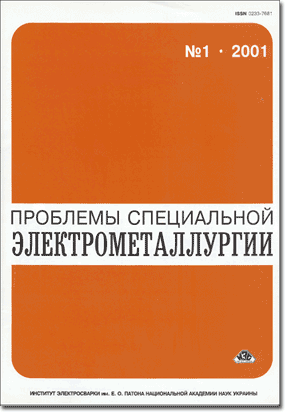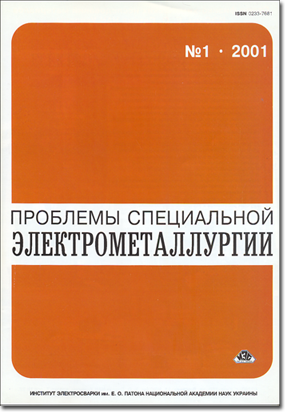

ELECTROSLAG TECHNOLOGY
Medovar B. I., Medovar L. B., Saenko V. Ya. Electroslag technologies in the XXI century
The state-of-the-art and prospects of development of electroslag technologies in the XXIst century are considered. It is shown that the future will belong to all the varieties of electroslag technologies which use the liquid filler metal. P. 12
Lantsman I. A., Yakovlev S. G., Medovar L. B. System of automation of the electroslag remelting furnace
System of automation of the electroslag remelting furnace, implemented at the Engineering Center of electroslag technologies of the E.O.Paton Electric Welding Institute, is presented. A special attention is paid to the technical aspects of using input-output devices, manufactured by companies "Holit Data Systems" (Kiev) and "L-Card" (Moscow), and also a graphical system of programming LabVIEW of "National Instruments" company (USA). The project was realized by the "Elmet-Roll" company during 1998-1999. P. 18
ELECTRON BEAM PROCESSES
Akhonin S. V. Mathematical modelling of process of dissolution of TiN inclusions in titanium melt during EBM
Mathematical model of process of dissolution of nitride non-metallic inclusions in the melt of titanium alloys, establishing the relationship between the rate of dissolution of particles and the melt temperature, has been constructed. The time of complete dissolution of nitrogen-containing inclusions of different chemical composition and initial sizes was defined with respect to the electron beam melting conditions. P. 20
Kozlovets O. N., Tregub N. P., Pikulin A. N. Removal of non-metallic inclusions and gases from nickel-based alloys in electron beam melting with an intermediate crucible
Results of comparative investigations of quality of nickel-based alloys using open arc, vacuum-arc melting and electron beam remelting with an intermediate crucible are given. The effect of remelting on the content of non-metallic inclusions and gases was examined. It is shown that the most complete refining is provided from hydrogen whose residual content does not exceed 0.00006...0.00009 %. During EBMIC the metal is refined from harmful gas impurities, and the non-metallic inclusions are decreased in sizes and distributed more uniformly in the ingot section. P. 24
PLASMA-ARC TECHNOLOGY
Sheiko I. V., Latash S. V., Konstantinov V. S., Stepanenko V. V. About the problem of application of independent heat sources for utilization of industrial waste of titanium and its alloys
Analysis of remelting titanium waste using independent heat sources is given. Application of plasma-arc remelting and induction melting in a sectioned mould is emphasized. Technical characteristics of plasma-arc furnace of UP-100 type and induction furnace of OP-117 type with a sectioned mould, as well as chemical composition of titanium ingots produced from waste in these furnaces are described. The application of the latter is promising for utilization of waste of titanium and its alloys. P. 27
VACUUM-INDUCTION MELTING
Grigorenko G. M., Sheiko I. V., Pomarin Yu. M., Chadyuk E. N., Orlovsky V. Yu. Development of technological principles of melting of homogeneous ingots of titanium aluminide in water-cooled moulds using plasma-arc and induction sources of heating
It is shown that the use of plasma-arc remelting and induction melting in a sectioned mould is rational for producing titanium aluminide ingots of a high chemical homogeneity. Technological recommendations for melting homogeneous ingots are issued, comprehensive examination of the material produced is carried out and the feasibilty of a single-stage technology of cast titanium aluminide production is grounded. P. 32
GENERAL PROBLEMS OF METALLURGY
Medovar L. B., Tsykulenko A. K., Shevchenko V. E. Modern mill rolls, requirements, materials and methods of production
Data are presented about the status in production of working and supporting rolls of different types of mills. Existing directions in the selection of roll materials and technology of their production are analyzed. The steady tendency in using composite rolls with a working layer made from high-alloyed materials is stated on the basis of the analysis. P. 38
Moisov L.P., Burylyov B.P. Calculation of nitrogen solubility in iron-based molten alloys
The present equation for the calculation is based on the basis of the formula for the gas dissolubility in binary and multi-component systems its adaptability to nitrogen solutions in melts. The checking of the expression was made in comparison with the calculation results with the experimental data for the systems: Fe-Ni-N, Fe-Co-N, Fe-Cu-N, Co-Ni-N and the dependence for the not studied systems Co-Cu-N, Ni-Cu-N was predicted. P. 49
INFORMATION P. 52
Advertising 61
(You are viewing the simplified file contents)
The cost of subscription/purchase order journals or individual articles
| Journal/Currency | Annual Set | 1 issue printed |
1 issue |
one article |
| TPWJ/USD | 384 $ | 32 $ | 26 $ | 13 $ |
| TPWJ/EUR | 348 € | 29 € | 24 € | 12 € |
| TPWJ/UAH | 7200 UAH | 600 UAH | 600 UAH | 280 UAH |
| AS/UAH | 1800 UAH | 300 UAH | 300 UAH | 150 UAH |
| AS/USD | 192 $ | 32 $ | 26 $ | 13 $ |
| AS/EUR | 180 € | 30 € | 25 € | 12 € |
| SEM/UAH | 1200 UAH | 300 UAH | 300 UAH | 150 UAH |
| SEM/USD | 128 $ | 32 $ | 26 $ | 13 $ |
| SEM/EUR | 120 € | 30 € | 25 € | 12 € |
| TDNK/UAH | 1200 UAH | 300 UAH | 300 UAH | 150 UAH |
| TDNK/USD | 128 $ | 32 $ | 26 $ | 13 $ |
| TDNK/EUR | 120 € | 30 € | 25 € | 15 € |
AS = «Automatic Welding» - 6 issues per year;
TPWJ = «PATON WELDING JOURNAL» - 12 issues per year;
SEM = «Electrometallurgy Today» - 4 issues per year;
TDNK = «Technical Diagnostics and Non-Destructive Testing» - 4 issues per year.





